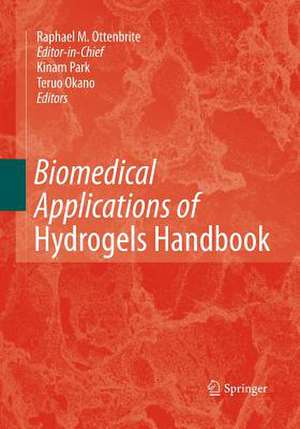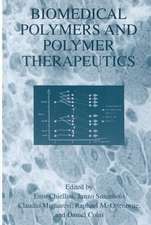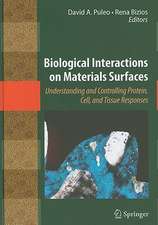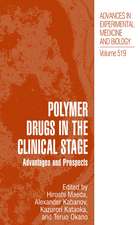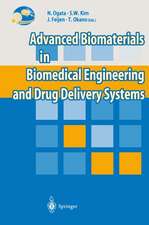Biomedical Applications of Hydrogels Handbook
Nicholas A. Peppas Editat de Raphael M. Ottenbrite, Kinam Park, Teruo Okanoen Limba Engleză Paperback – 22 aug 2016
Key Features:
- Provides comprehensive coverage of the basic science and applications of a diverse class of materials
- Includes both naturally occurring and synthetic hydrogels
- Edited and written by world leaders in the field.
| Toate formatele și edițiile | Preț | Express |
|---|---|---|
| Paperback (1) | 957.13 lei 6-8 săpt. | |
| Springer – 22 aug 2016 | 957.13 lei 6-8 săpt. | |
| Hardback (1) | 964.71 lei 6-8 săpt. | |
| Springer – 2 sep 2010 | 964.71 lei 6-8 săpt. |
Preț: 957.13 lei
Preț vechi: 1167.23 lei
-18% Nou
Puncte Express: 1436
Preț estimativ în valută:
183.14€ • 191.73$ • 151.54£
183.14€ • 191.73$ • 151.54£
Carte tipărită la comandă
Livrare economică 05-19 aprilie
Preluare comenzi: 021 569.72.76
Specificații
ISBN-13: 9781493950522
ISBN-10: 1493950525
Pagini: 432
Ilustrații: XX, 432 p.
Dimensiuni: 178 x 254 mm
Greutate: 0.78 kg
Ediția:Softcover reprint of the original 1st ed. 2010
Editura: Springer
Colecția Springer
Locul publicării:New York, NY, United States
ISBN-10: 1493950525
Pagini: 432
Ilustrații: XX, 432 p.
Dimensiuni: 178 x 254 mm
Greutate: 0.78 kg
Ediția:Softcover reprint of the original 1st ed. 2010
Editura: Springer
Colecția Springer
Locul publicării:New York, NY, United States
Descriere
Hydrogels are networks of polymer chains which can produce a colloidal gel containing over 99 per cent water. The superabsorbency and permeability of naturally occurring and synthetic hydrogels give this class of materials an amazing array of uses. These uses range from wound dressings and skin grafts to oxygen-permeable contact lenses to biodegradable delivery systems for drugs or pesticides and scaffolds for tissue engineering and regenerative medicine. Biomedical Applications of Hydrogels Handbook provides a comprehensive description of this diverse class of materials, covering both synthesis and properties and a broad range of research and commercial applications. The Handbook is divided into four sections: Stimuli-Sensitive Hydrogels, Hydrogels for Drug Delivery, Hydrogels for Tissue Engineering, and Hydrogels with Unique Properties.
Key Features:
Key Features:
- Provides comprehensive coverage of the basic science and applications of a diverse class of materials
- Includes both naturally occurring and synthetic hydrogels
- Edited and written by world leaders in the field.
Cuprins
1] Introduction to HydrogelsHossein Omidian and Kinam ParkPART 1: STIMULI-SENSITIVE HYDROGELS2] Stimuli Responsive Hydrogels and their Application to Functional Materials Ryo Yoshida and Teruo Okano3] Feedback control systems using environmentally and enzymatically sensitive hydrogelsIrma Y. Sanchez and Nicholas A. Peppas4] Biomolecule-Responsive HydrogelsTakashi Miyata5] Stimuli-Responsive PEGylated Nanogels for Smart Nanomedicine Motoi Oishi and Yukio Nagasaki6] Stimuli-Sensitive Microhydrogels Haruma KawaguchiPART 2: HYDROGELS FOR DRUG DELIVERY7] In Situ Gelling Stimuli-Sensitive PEG Based Amphiphilic Copolymer HydrogelsDoo Sung Lee and Chaoliang He8] Biodegradable Hydrogels For Controlled Drug ReleaseLuis García, María Rosa Aguilar and Julio San Román9] Thermo-Responsive Biodegradable Hydrogels from Stereocomplexed Poly(lactide)sTomoko Fujiwara, Tetsuji Yamaoka, Yoshiharu Kimura10] Hydrogel Based Drug Delivery System with Molecular Imaging Keun Sang Oh and Soon Hong YukPART 3: HYDROGELS FOR TISSUE ENGINEERING11] Hydrogels for Tissue Engineering ApplicationsPieter J. Dijkstra12] Composite Hydrogels for Scaffold Design, Tissue Engineering And ProsthesesV.Guarino, A.Gloria, R. De Santis and L.Ambrosio13] Hydrogels for Cartilage Tissue Engineering Pierre Weiss, Ahmed Fatimi, Jerome Guicheux, Claire Vinatier14] Gelatin Based Hydrogels for Controlled Cell Assembly Xiaohong Wang, Yongnian Yan, Renji Zhang15] Double Network Hydrogels as Tough, Durable Tissue SubstitutesTakayuki Murosaki andJian Ping Gong 16] Hydrogels for Contact LensesJiri Michalek, Radka Hobzova, Martin Pradny, Miroslava Duskova PART 4: HYDROGELS WITH UNIQUE PROPERTIES17] Electroconductive HydrogelsAnn Wilson,Gusphyl Justin and Anthony Guiseppi-Elie18] Polysaccharide Engineered Nanogels Nobuyuki Morimoto and Kazunari Akiyoshi19] Engineered High Swelling HydrogelsHossein Omidian and Kinam Park20] Superabsorbent Hydrogels Grigoriy Mu, Ibragim Suleimenov, Kinam Park, Hossein Omidian
Textul de pe ultima copertă
Hydrogels are networks of polymer chains which can produce a colloidal gel containing over 99 per cent water. The superabsorbency and permeability of naturally occurring and synthetic hydrogels give this class of materials an amazing array of uses. These uses range from wound dressings and skin grafts to oxygen-permeable contact lenses to biodegradable delivery systems for drugs or pesticides and scaffolds for tissue engineering and regenerative medicine. Biomedical Applications of Hydrogels Handbook provides a comprehensive description of this diverse class of materials, covering both synthesis and properties and a broad range of research and commercial applications. The Handbook is divided into four sections: Stimuli-Sensitive Hydrogels, Hydrogels for Drug Delivery, Hydrogels for Tissue Engineering, and Hydrogels with Unique Properties.
Key Features:
Nicholas A. Peppas, Chair (The University of Texas at Austin)
Allan Hoffman (University of Washington)
Emo Chiellini (University of Pisa)
Fu-Zhai Cui (Tsinghua University)
Karel Dusek (Academy of Sciences of the Czech Republic)
Jindrich Kopecek (University of Utah)
Claudio Migliaresi (University of Trento)
Yoshihito Osada (Hokkaido University)
Buddy D. Ratner (University of Washington)
Nathan Ravi (Washington University in St. Louis)
Etienne Schacht (Ghent University)
Tianwei Tan (Bejing University of Chemical Technology)
Key Features:
- Provides comprehensive coverage of the basic science and applications of a diverse class of materials
- Includes both naturally occurring and synthetic hydrogels
- Edited and written by worldwide leaders in the field
Nicholas A. Peppas, Chair (The University of Texas at Austin)
Allan Hoffman (University of Washington)
Emo Chiellini (University of Pisa)
Fu-Zhai Cui (Tsinghua University)
Karel Dusek (Academy of Sciences of the Czech Republic)
Jindrich Kopecek (University of Utah)
Claudio Migliaresi (University of Trento)
Yoshihito Osada (Hokkaido University)
Buddy D. Ratner (University of Washington)
Nathan Ravi (Washington University in St. Louis)
Etienne Schacht (Ghent University)
Tianwei Tan (Bejing University of Chemical Technology)
Caracteristici
First comprehensive handbook since 1987 on the basic science and applications of an important and diverse class of materials
Covers applications to medicine and drug delivery, cosmetics and other consumer products, foods, agriculture, nanotechnology, and environment-sensitive sensing devices
Describes both naturally occuring and synthetic hydrogels
Edited and written by world leaders in the field
Includes supplementary material: sn.pub/extras
Covers applications to medicine and drug delivery, cosmetics and other consumer products, foods, agriculture, nanotechnology, and environment-sensitive sensing devices
Describes both naturally occuring and synthetic hydrogels
Edited and written by world leaders in the field
Includes supplementary material: sn.pub/extras
